Using Data to Build a Demand Generation Engine
B2B marketing is a lot of what-have-you-done-for-me-lately and a never-ending game of follow the leader. But that’s what makes it so fun: its fast-moving nature keeps us on our toes and constantly looking for ways to improve.
Some marketers see ROI on TikTok? Sign me up.
Google PPC ads still drive a solid cost per lead (CPL)? A little boring, but if that’s where I’m going to get the most bang for my buck, let’s do it.
People actually click on B2B ads on Facebook? Wow.
While we’re all playing from the same B2B marketing playbooks, your interpretation of them will (and should) vary from your peers.
Throwing spaghetti at the wall can be fun, but doing so simply because something’s working for everyone else is a recipe for disaster (and wasted spend).
In 2023 and beyond, it’s imperative to keep everyone’s favorite tactics in mind but only invest in the ones putting closed-won deals in your pocket.
The only way to do that is by building a data-driven demand generation engine.
This article will walk you through the steps necessary to do that.
Rather watch a video? Shiv Narayanan, Founder and CEO of How to SaaS, dove into this topic during DEMAND 2022. Check it out here.
Understand your company dynamics + marketing maturity
There’s a relatively “accepted way” to drive revenue in the B2B world: A demand generation strategy built on the back of a mix of PPC, paid social, and events will usually do the trick. Display works for some but it doesn’t work for everyone.
Using these tactics without regard for company dynamics and marketing maturity is reckless. Every company has a unique marketing puzzle with pieces—the tactics above—that fit together differently.
Understanding how to build your demand generation strategy starts by pinpointing where you’re at, both as a company and marketing team.
5 stages of marketing maturity
- New GTM: A startup driven by the founder with limited involvement from Marketing. Kind of like Amazon in 1995 when Jeff Bezos’ motto was “get big fast,” and he was using a door as a desk.
- Sales-led: The founder has relinquished some control and tasked the Sales team with driving revenue. Meanwhile, the Marketing team plays a supporting role akin to Jonah Hill in The Wolf of Wall Street.
- Nascent marketing: Marketing has entered the chat and contributes 10-15% of the pipeline. The team usually is a small band of scrappy marketers asked to do a lot with a little.
- Some marketing impact: Marketing is embedded in the company’s growth engine, contributing 15-25% of the pipeline. The team is growing and adding more specialized roles to scale quickly.
- Sophisticated: Sophisticated Marketing teams are rare and often reserved for industry behemoths. The driving force behind their companies, they contribute 25-50% of the pipeline thanks to their big teams and even bigger budgets.
Where do you fall? It’s hard to say, but we’d wager a guess somewhere between 2 and 4. Most B2B companies do.
Your goal for 2023 is to get to that next stage. But to do that, you need to understand the sophistication level of your marketing initiative.
Pyramid to marketing sophistication
Think of pipeline and revenue growth the same way you think about your car’s engine. You need a lot of moving pieces working together to keep it running.
To get your demand generation engine operating on all cylinders, you need everything in your marketing orbit to be aligned.
There are five levels:
- Foundation: Business content, funnel efficiency, market analysis, customer analysis, and branding
- Infrastructure: Tech stack, website, product marketing, and revenue operations
- Planning: Strategy, demand generation, and content
- Resourcing: Team and budget
- Outcome: Revenue growth
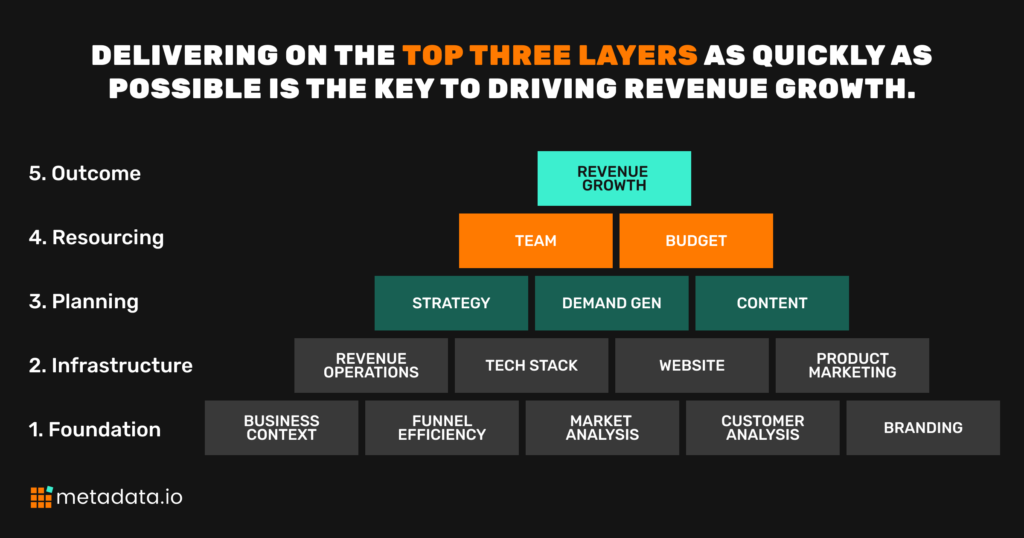
The companies with unpredictable marketing contributions and low revenue impact are the ones that jump around the pyramid. They move on to the next level without solidifying the one below it.
For example, they could have a solid website but need revenue operations to track performance properly. Or they have a sophisticated demand generation program but need more team members to power it for the long haul.
Then, there are the ones that let forcing functions via acquisitions, business exits, M&As, and leadership transitions accelerate the build. That’s when things really get messy.
Demand generation engines built to survive and thrive are constructed the right way the first time; they’re constructed with data and gradually scaled.
Pro tip: Getting to revenue growth ASAP should be your top priority. While it’s important to trek through all layers of the pyramid, don’t obsess over making things perfect on Day 1. Instead, develop an MVP, start your engine, and optimize as you go.
“The top half of this pyramid is where the bulk of the value is created,” Narayanan said in his DEMAND session, Using Data To Build a Demand Gen Engine. “The quicker we can get to that part, the easier it’ll be to deliver on our targets.”
The biggest mistake marketing leaders make, especially in a down economy, is pouring too much political capital into projects that don’t drive a return, e.g., getting branding spot-on or building the perfect tech stack.
How to scale your demand generation engine with data
Anyone in B2B, regardless of size, vertical, operating model, company dynamics, and marketing sophistication, can benefit from demand generation.
Of course, these variables will spawn strategies of different shapes and sizes. What won’t change, however, is the data that goes into them and their role in scaling.
Funnel tracking
Walk into any B2B company’s war room, and you’ll see quotas, pipeline targets, active deals, and other data isolated to the Sales team plastered on the walls—and that’s fine.
Most, if not all, B2B companies start as sales-led organizations, meaning that they build processes and operational models to measure sales impact.
The right demand-generation strategy lessens the load on sellers by opening additional streams of high-quality leads and revenue.
The pressing question is which streams you should rely on and which ones you should let dry up.
“Is the effort that we’re putting into marketing actually driving revenue growth?” Narayanan asks.
To start wrapping your head around that answer, build out MQL-to-Close reporting.
- How many new MQLs are you bringing in?
- How many new opportunities are coming from existing customers?
- What percentage of these opportunities are getting to closed-won business?
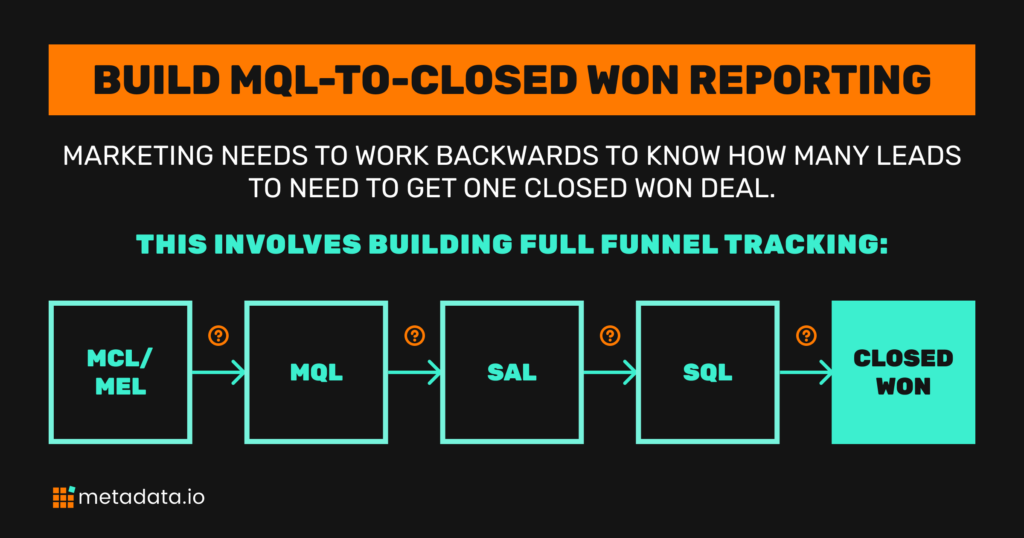
At the same time, look at other metrics, including form submissions, website traffic, and Sales Accepted Leads (SALs), to gauge the efficiency of your funnel across every stage of the buying process.
Your ultimate goal is to figure out how many leads, MQLs, or opportunities you need at the top of the pipeline to hit your goals and, more importantly, what that deal’s worth to you.
Identify the baseline (for cost per lead)
What’s your acceptable cost-per-lead (CPL)?
Your CPL—or the dollar amount you can spend to acquire a customer given channel-specific conversion rates—is your north star.
To calculate this, divide the cost to generate leads (typically total ad spend) by the number of leads generated.
So, if a campaign generated 100 leads and cost you $10,000, your CPL would be $100.
You’ll use this number to determine whether channels and campaigns are performing as expected.
From there, you can allocate spend accordingly.
Note: There’s no right or wrong CPL. While you should always aim for a lower number, your strategies and tactics are working if you’re growing with a given CPL. Keep it up.
Channel analysis
The accepted theory is that B2B marketers need to do [insert a tactic here] to grow. LinkedIn, for example, has entrenched itself into the hearts and minds of marketers.
It’s accepted as a safe haven for ad dollars and a default channel, which is why around half of marketers in the U.S. use it.
I’ll be the first to admit that I’m a LinkedIn fan, but I still have to acknowledge the breadth of the advertising world. Our 2022 paid social benchmark report makes it clear that LinkedIn isn’t the only horse in the race.
While ad dollars will undoubtedly go to LinkedIn, don’t just throw them there because that’s what everyone’s doing. Instead, run a channel analysis to determine which channels and campaigns are having the most impact on your bottom line.
How? Use your baseline CPL and compare it to channel-level metrics.
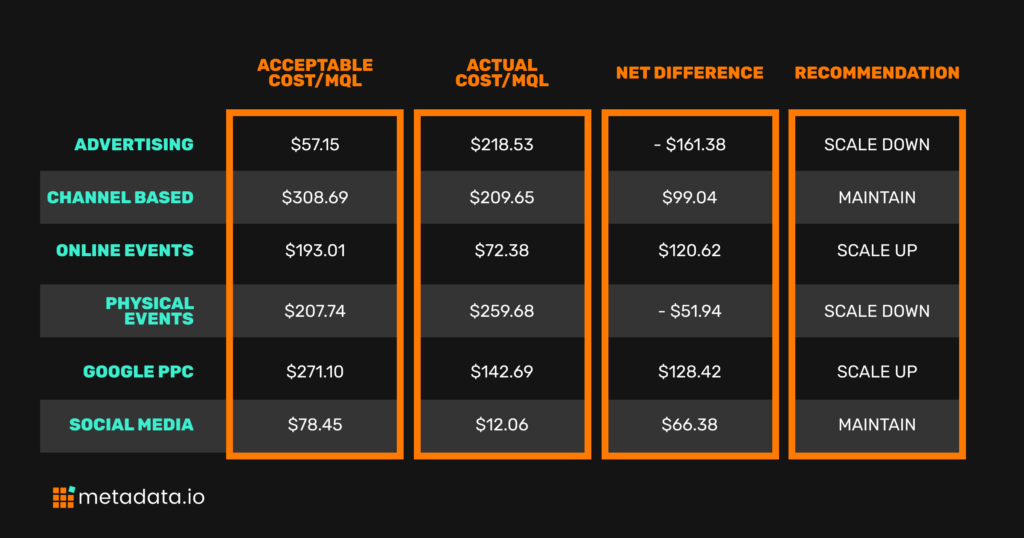
Identify opportunities and scale
Which channels and campaigns are driving the most pipeline? Which ones are drying up?
Use your channel analysis to understand the ROI on a channel-by-channel basis, uncover inefficiencies, and reallocate spend to the channels moving the needle.
Based on the table above, you’d likely want to move funds away from advertising and physical events to more profitable channels, like Google PPC.
In 2023, this budget juggling act will be that much more valuable. When times are tough and belts are tightening, bringing this level of detail to the leadership team will instill confidence and help you secure more budget, which is no easy task.
According to The State of B2B Marketing Budgets 2022, 60% of B2B marketers report current budgets being cut or staying flat.
“A lot of Marketing teams point out that they’re short on budget,” Shiv says. “This type of exercise [a channel analysis] is a great way to find additional budget from activities that aren’t that profitable to begin with.”
Pro tip: Work backward. Start by reallocating spend to the channels and tactics aimed at high-intent audiences, i.e., those lower in the funnel. While brand and product awareness are good, it’s easier and more affordable to convert people who know they have a problem and your product can solve it.
You should also look for opportunities to grow from inside your walls. For example, launch campaigns to help your AEs upsell, create content to help your CSMs increase the lifetime value of existing customers, or launch a partner program.
In 2023, net revenue retention and customer expansion will be your friends.
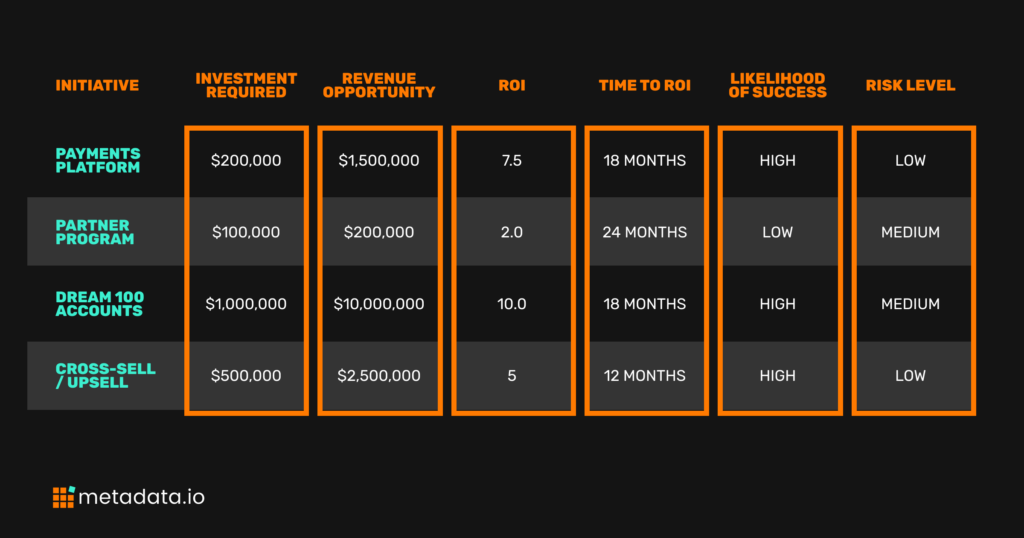
Hiring
Scaling demand generation isn’t purely financial. A big part of it involves scaling headcount.
As you ramp up your demand-generation engine and secure more budget, ensure some of it goes to new hires who can help you achieve your increasingly lofty goals.
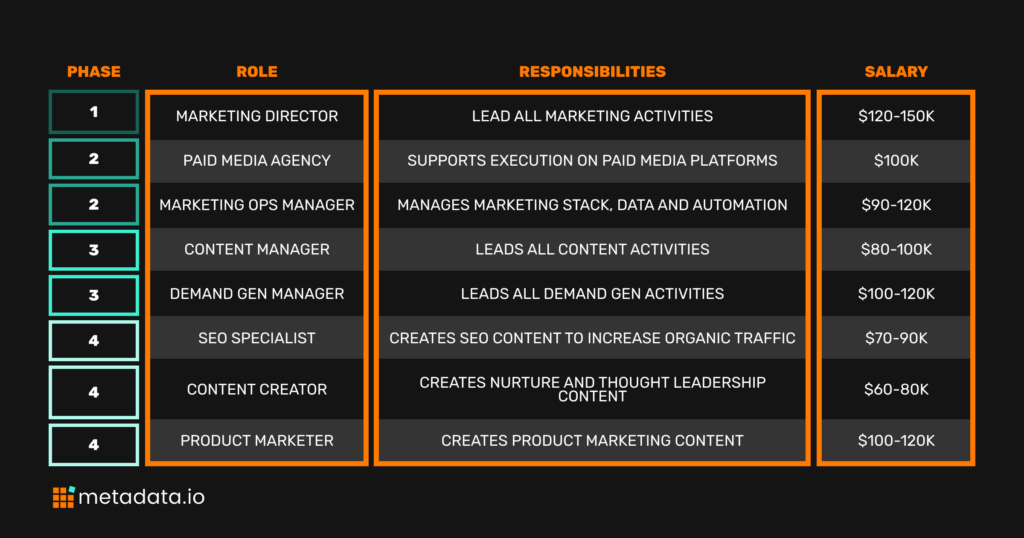
Not sure which role to add?
Tie the roles and budget to strategic opportunities. For example, if your biggest opportunity in the coming quarters is to help your Sales team close more deals and overcome prospect pushback, a product marketer may make sense.
Meanwhile, if your goal is to dip your toes into more complex channels, a paid media agency with specialized expertise could be high on your wishlist.
Not only will this help you build a smart roadmap and realistic timeline, but the alignment will help your leadership team understand your vision and give them the confidence to hand over the extra funds.
Be scientific about marketing
For better or worse, marketing is a function of its available budget after it becomes efficient.
With more money comes more power. But it also comes with greater expectations.
If you have the right infrastructure to understand what’s working and know how to use data to make strategic decisions, those expectations will never be too high.
Remember: Demand generation can help everyone, but there’s no right or wrong way to do it. Strategies don’t fit into a shoebox. Scaling your strategy—and reaching the top of the marketing pyramid—will take time and require you to climb a unique path.
Don’t assume this way or that way will work because your 2nd connection on LinkedIn is hyping it up. Find what works for you and become a rockstar.
(Plus, we all know what they say about making assumptions.)
To watch Shiv Narayanan’s full talk, check out his DEMAND session here.


